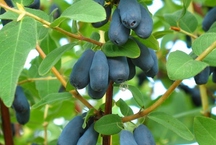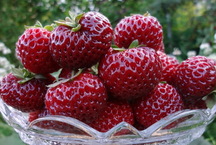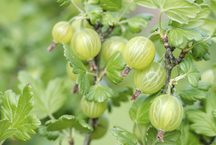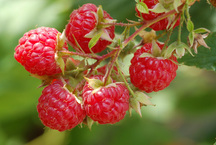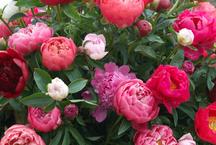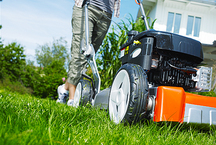Top 10 blueberry varieties





Garden blueberries on the dacha plots are still a wonder, but experienced gardeners have already found an approach to it. Capricious savage miserly on the crop, but wishing to eat from the bush useful and tasty berries grows every year. We present you the description and photos of the best varieties of blueberries - according to experienced gardeners.
In breeding work using 3 promising species:
- blueberry ordinary (marshy), common in Siberia and having a height of up to 1 meter;
- narrow-leaved blueberrygrowing in the east of North America and featuring record winter hardiness and a height of 0.5 - 0.7 meters;
- American blueberry tall (to 2,5 meters), differing in high and regular productivity.
Blueberries are valued for their nutritional and healing properties. Berries ripen at the end of summer, which allows you to extend the use of fresh sources of vitamins. The berry bush is very decorative both in the period of flowering, covered with white bells, and in the autumn with reddening foliage. Often, gardeners planted blueberries in floral arrangements with rhododendrons and horsetails.
Blueberries do not give high yields: do not count on more than 2 to 4 kg per bush. Her plant for delicacy and fresh use. In the fruiting varietal seedling comes late: 4 - 5 year. In terms of ripening allocate early, middle and late varieties of blueberries. Under the conditions of the Moscow region, it is advisable to grow early and medium ripening blueberry varieties that have time to ripen and give away 100 or 80% of the crop. Blueberries are self-fertile, but the joint planting of several varieties significantly increases the productivity of the bushes.
Top Blueberry Varieties Rating
| Category | A place | Name | Rating | Price |
|---|---|---|---|---|
| The best tall blueberry varieties | 1 | Duke | 9.9 / 10 | 350 |
| 2 | River (Reka) | 9.9 / 10 | 500 | |
| 3 | Spartan (Spartan) | 9.8 / 10 | 500 | |
| 4 | Toro (Toro) | 9.8 / 10 | 1 500 | |
| 5 | Patriot (Patriot) | 9.8 / 10 | 500 | |
| The best undersized varieties of blueberries | 1 | Northblue | 9.9 / 10 | 1 500 |
| 2 | Northcounry | 9.8 / 10 | 500 | |
| 3 | Northland | 9.8 / 10 | 1 250 | |
| 4 | Chippewa | 9.7 / 10 | 550 | |
| 5 | Polaris (Polaris) | 9.7 / 10 | 600 |
The best tall blueberry varieties
|
Duke
350 (root in the bag with wet moss)
Superearly large-fruited variety of American selection blueberry. Due to the relatively uniform ripening of berries, the number of fees is reduced. Bush 130–180 cm tall, with a broad crown, medium growth rate, restrained lateral branching and shoot formation. The berries are light blue, with an average wax bloom, weighing up to 2.5 g, with a diameter of 1.7 - 2.0 cm, dense, sweet with tartness and fruit and wine aftertaste. The skin is dense, crispy. In clusters of berries of different sizes. Potential yield of more than 6 kg. Winter hardiness is average, severe damage in winters with little snow. This grade of a blueberry is good for the Average strip and the Moscow region.
Main advantages:
Minuses:
|
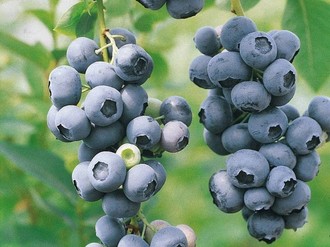 9.9 / 10
Rating
Reviews
Young bushes slowly increase productivity, but the taste of the berries is excellent, by 5 points. |
|
River (Reka)
500 (2-year-old sapling in a container)
Early ripe New Zealand variety of blueberry grown on an industrial scale on plantations of Canada. The bush height of 170 - 200 cm, powerful, highly branched, shows high growth energy. In the middle zone unfriendly ripens in the middle - the end of July. The berries are saturated blue, with a moderate wax coating, weighing 1.5 - 1.8 g, with a diameter of up to 1.5 cm, dense. Tasters taste highly, with a blueberry dessert aftertaste, there is a pleasant aroma. Berries in clusters of 8 - 10 pcs. The first fruiting is possible already for 3-4 years. With high agricultural technology, you can count on a harvest of 4 - 5 kg per adult bush. After collecting the berries are stored for 7 - 10 days.Winter hardiness of this variety of blueberry is sufficient for growing in the middle zone and the Moscow region. The variety is often recommended for beginners, as the most unpretentious.
Main advantages:
Minuses:
|
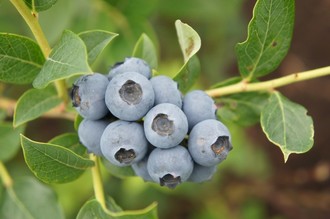 9.9 / 10
Rating
Reviews
The most fruitful of my 7 varieties of blueberries, ripen early, young growth always has time to ripen before cold weather. |
|
Spartan (Spartan)
500 (two-year-old with a closed root system)
Our rating of the best varieties of blueberry continues to be the North American variety of medium ripening. Bush height of 150 - 200 cm, neat, upright, productive. Berries are pale blue, slightly flattened, with a strong wax coating, weighing up to 2 g, with a diameter of 1.5 - 1.8 cm. The taste is sweet with a pleasant sourness and tartness, there is a pronounced aroma. Clusters of medium size, friable. Differs moderate winter hardiness, after harsh winters quickly restored. Later flowering eliminates the risk of damage to the ovary by returning frosts, but threatens the aging of shoots.
Main advantages:
Minuses:
|
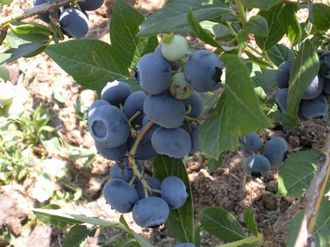 9.8 / 10
Rating
Reviews
Old and proven variety of blueberries, well adapted to the Russian climate. Gives the most delicious berries. |
|
Toro (Toro)
1 500 (two year old sapling from nursery)
Canadian mid-season variety of blueberry for industrial and amateur cultivation. The berries ripen in early August. Bush height up to 200 - 210 cm, compressed, compact, gives powerful gains. The berries are dark gray, rounded, with a medium waxy bloom, dense, weighing 3–4 g, 1.7–2.5 cm in diameter, one-dimensional, gathered in loose long clusters. Taste is sweet. Ripe fruits can remain on the branches without loss of quality. Forms the first berries in the 4th year of life, increasing the yield to 5 - 6 kg. It has a weak resistance to pathogens, therefore preventive treatments are required. This grade of a blueberry is recommended for Moscow area and the Middle strip.
Main advantages:
Minuses:
|
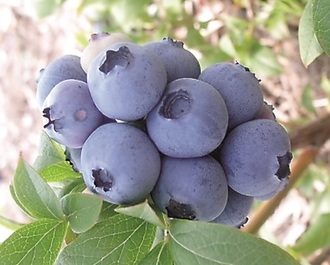 9.8 / 10
Rating
Reviews
Worthy variety with delicious high quality berries. Better manifests itself in a mild climate. |
|
Patriot (Patriot)
500 (2-year-old sapling in a container)
Reliable American variety of blueberry of medium ripening. Bushes average height of 120 - 160 cm, strongly branched. The berries are light blue, with a uniform waxy coating, flattened, in dense clusters, 1.5–1.9 cm in diameter, of various sizes, rather dense. Tastes are high. The yield of 5-year-old bushes with intensive cultivation technology reaches 6-7 kg. There are results of successful cultivation in the Moscow region and Khabarovsk. In responses, summer residents often characterize this variety of blueberry as hardy and hardy.
Main advantages:
Minuses:
|
 9.8 / 10
Rating
Reviews
This variety of blueberry is widely distributed and known, so it is easy to get on the transfer. In general, a decent grade. |
The best undersized varieties of blueberries
|
Northblue
1 500 (two year old sapling from nursery)
Popular hybrid of selection of the USA with genes from narrow-leaved blueberry. In Russia it ripens in average terms: the end of July - the beginning of August. Bush 60 - 90 cm tall, compact, decorative. The berries are dark blue, dense, with a diameter of 1.5 - 1.8 cm, collected in small clusters. In the conditions of an amateur garden the adult plant stably gives 1,5 - 2 kg of large berries.For commercial cultivation is not of interest. Winters safely in the central part of Russia.
Main advantages:
Minuses:
|
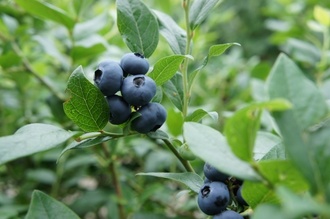 9.9 / 10
Rating
Reviews
This blueberry is not distinguished by high yields, but bears fruit every year and winters well. |
|
Northcounry
500 (2-year-old sapling in a 2 liter container)
American variety of blueberry, ripening in the middle terms. A bush no more than 90 cm high, compact, moderately sprawling, with powerful shoots. Berries are light colored, with a diameter of 1.2 - 1.5 cm, medium density, sweet and fragrant. After collection, it may be stored for more than 7 days when cooled. One bush stably gives 1.5 - 2 kg of berries. Together with other low-growing varieties recommended for cultivation in regions with severe winters. In the absence of snow cover, mulching of the lower part of the trunk or shelter is required. Main advantages:
Minuses:
|
 9.8 / 10
Rating
Reviews
This variety of blueberry is the best choice at the first stage of exploring the culture: not capricious, winter-hardy and self-fertile. |
|
Northland
1 250 (two year old sapling from nursery)
Early ripe variety of blueberries from Michigan, well adapted to the Russian climate. A bush about 100 cm high, stocky, spreading, strongly branched. The berries are light blue, of medium density, with a thin wax coating and delicate skin, weighing up to 2 g, with a diameter of 1.6 - 1.8 cm, sweet with a classic aroma. The potential productivity of an adult thick is 4-6 kg. The first harvest is received already from 2 - 3-year-old bushes. Under the conditions of the Middle Strip, the ripening of the berries shifts, and the variety becomes mid-season. Main advantages:
Minuses:
|
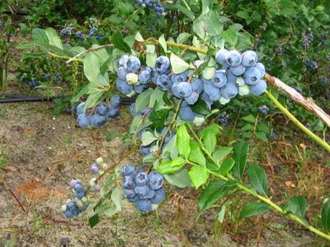 9.8 / 10
Rating
Reviews
In the suburbs blueberries Nortland perfectly manifests itself. The taste of berries is sweet, but simple. |
|
Chippewa
550 (two year old sapling)
A good grade of blueberry early ripening. The bush is 80 - 110 cm high, forms a compact spherical crown, the shoots are powerful and upright. The berries are bluish, with a diameter of 1.7 - 2 cm, very dense. Sugar dominates the taste, without sour, with a blueberry flavor, there is a strong aroma. The berries ripen not evenly, which is not convenient for blanks, but is suitable for consumption from the bush. The yield of an adult bush exceeds 3 kg. It is somewhat inferior in winter hardiness to the varieties described above, but in conditions of the Moscow Region it winters without damage. Main advantages:
Minuses:
|
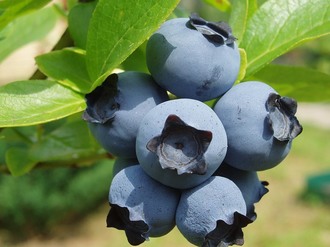 9.7 / 10
Rating
Reviews
In my collection it is the earliest and abundantly fruiting undersized variety. |
|
Polaris (Polaris)
600 (two-year sapling with closed root system)
A promising variety of American blueberry breeding of medium ripening. Shrub up to 100 - 120 cm, with straight shoots, strongly branched. The berries are sky-blue, aligned, regular shape, weighing 1.5 g, with a diameter of 1.0 - 1.4 cm, very tasty, sour-sweet and fragrant, collected in small clusters. The skin is strong, ripe berries do not burst and do not crumble. The average yield of one adult bush is from 1.5 to 2 kg. Fruiting begins at 3 - 4 years of life. Blueberry Polaris winters well and bears fruit in central Russia and Moscow region. Main advantages:
Minuses:
|
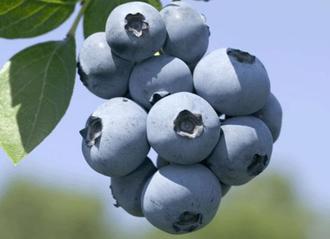 9.7 / 10
Rating
Reviews
In the north of the Moscow region proved to be a reliable variety with dessert berries. |
Features of growing blueberries
In its natural habitat, blueberries grow on peat soils of high acidity. Novice gardeners are frightened by the "unusual" culture requirements for soil and care. To give the bushes a good growth and high yield, it is recommended to create the following conditions:
- the plot is well lit - even in the penumbra, the yield drops sharply
- wind protection;
- soil acidity 4-5 units: annual acidification and addition of colloidal sulfur;
- easy friable soil with good air permeability;
- regular moistening - to prevent the top layer from drying out;
- the soil under the bush is mulched with sawdust, bark, wood chips or coniferous litter;
- use of acidic mineral fertilizers.
The need for acidification is determined by the result of the pH of the soil solution. Only sour peat is added to the landing pit. Do not create an artificial marsh, as the roots need constant access to fresh air. On heavy clay soils and in conditions of periodic flooding, blueberries will not grow.
Blueberry bushes grow slowly, there is a stretching of all phenophases, in particular, extended flowering and uneven ripening of berries. Fruiting bushes greatly eats thrushes, and in winter, shoots are attacked by hares, so protection measures are required: nets from birds and a lapnik shade from hares.
Adult fruiting blueberry bushes must be pruned annually. The procedure is carried out with 6 years of age, removing all old shoots and freeing the lower part. Leave 3–5 fat healthy annual shoots. For young landings and in regions with frequent winters with little snow, cover with spruce branches or agrofibre is necessary.
When choosing planting material, preference should be given to annual seedlings with a closed root system. When planted, the roots, after being removed from the pot, are straightened in order to exclude further stopping the growth of a healthy plant. Blueberry tolerates transplant at any age.
Have a good harvest!
